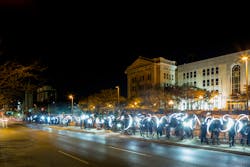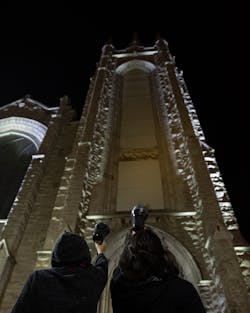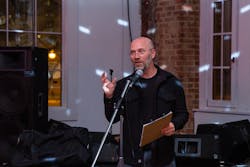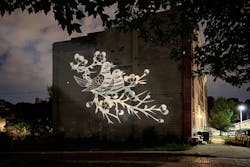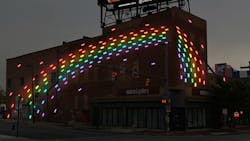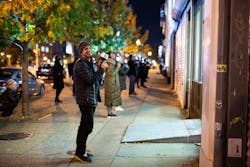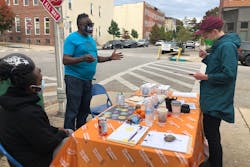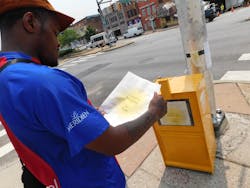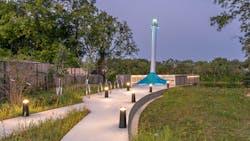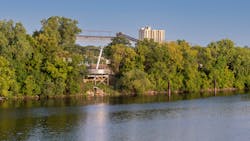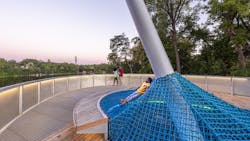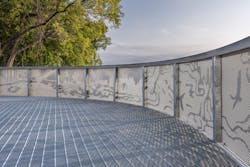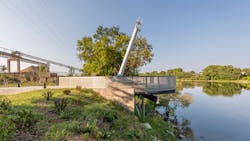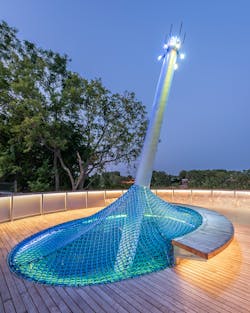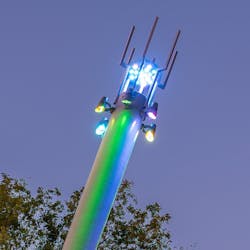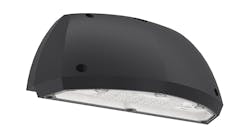Every so often, lighting designers will include pro bono and nonprofit projects into their workload to contribute positively to society at large, beyond the clients that can afford professional lighting services. Glenn Shrum, founder and principal of New York– and Baltimore-based Flux Studio, had become increasingly aware of social injustices in recent years. “We typically work for wealthy people and we typically talk to the decision-makers,” he said, “but that leaves a lot of people behind and a lot of people out of the process.”
Unexpected site conditions, political and bureaucratic pushback, and budget cuts can derail any project. Fighting to keep alive a community project with no direct quantifiable or conventional metrics for success, such as ROI, can be stressful for even the most earnest designers. “We’re advocating for … doing what’s right for people, especially disenfranchised folks — people of color whose voices haven’t been part of these processes,” said James Garrett Jr., founder of 4RM+ULA, an architectural design firm in St. Paul, Minn. Trying to convince number-crunchers of the value of reconnecting a community to green space or of the need for additional funding to remediate newly discovered contaminated soil can be “a difficult, lonely place to be a lot of times,” Garrett said, but he continues “to advocate because nobody else will.”
Empowering Light City
Shrum’s interest in community lighting projects grew in part from his eight-person firm’s desire to engage more with its hometown of Baltimore. In mid-2019, the locally based Neighborhood Design Center with design lead Flux Studio received several grants to increase light access for the city’s Station North Arts District.
The result was Signal Station North (SSN), a conceptual and detailed lighting plan that includes demonstrations, lighting projects, design concepts, and educational resources. “Lighting holds a lot of power,” Shrum said. “If we, as a lighting design community, don’t figure out how to make people want to engage in topics about light … so that they can advocate for their own interests, then we aren’t sharing that power.”
Part of gaining a community’s trust, Shrum said, is managing expectations. The wish list of specific and aspirational lighting requests from residents at the start of SSN quickly grew long. “If you communicate directly and clearly … and you don’t mislead anyone, then it helps build that trust,” Shrum said. “But it also leads to some disappointment.”
Flux Studio with architectural designer PI.KL Studio and design studio Public Mechanics envisioned a series of public interventions that would improve lighting “at a municipal, neighborhood, and individual scale” and create “a nighttime environment with uniform street lighting, gentle light spill from storefronts and residences, and a warmer color temperature punctuated by inventive, colorful lighting installations,” according to SSN Lighting Guidebook, one of the project’s deliverables.
The team took its design concepts as far as it could, to be shovel ready and replicable when additional funding comes through. It documented design and planning logistics, including how to find power supply for public projects; strategically identified sites and suppliers; and compared cost estimates from installers.
Of its array of ideas, the team hopes to move forward with three concepts. “Signal Light Gallery” comprises a rotating show of luminous art projected onto building façades. The team identified logistical questions of who would curate the show, coordinate the artist lineup, and request owner permissions. Though the project requires minimal equipment — just a light fixture — the team needed to find an adjacent property with power to mount the fixture.
“Our intent was to install the light fixtures on street poles,” Shrum said. “They already have power, it’s public infrastructure, and they’re always where we need them to be.” However, the two owners of the city’s streetlights, Baltimore Gas and Electric and the Department of Transportation, would not grant permissions for “bureaucratic reasons.”
Several private owners have expressed interest, Shrum continued, but their enthusiasm often wanes once the owner must formally commit. “It’s challenging because it’s not their priority. It might be your priority, but it’s not their priority.”
In the demonstration project “Modular Light Fixtures,” which arrayed rectangular LED modules onto building façades to create street art, the designers learned another way that community projects differ from private commissions. Shrum and his colleagues initially sketched abstract, geometric compositions for LED modules. Meanwhile, community members had more literal concepts, such as creating flowers out of the modules for a site that makes natural dyes from community garden plants. Though a private client might select a lighting designer for their portfolio, style, and brand, “lines that looked like typical architectural lighting moves were not going to be seen as being authentic and genuine," Shrum said. "When you hear through these community engagement processes that that’s what the community wants, you have to follow that and check your pride at the door.”
To keep costs low, the design team identified neon LED modules typically used for signage and sought quotes from signage installers. “If anyone wants to do anything like this,” Shrum said, “we can say, ‘This is the team, this is the cost.’”
The third project, “Field of Dreams,” uses spotlights to playfully illuminate and keep open a community-managed park after dark. This proposal was led by PI.KL, which recently finished “The Beacon,” a series of light totems installed in a previously ominous train underpass at Baltimore’s Last Mile Park. Each totem will feature a name of a local activist.
Beyond the design proposals, the team organized public events starting in fall 2019 though the COVID-19 pandemic would upend their agenda. Designers and residents discussed how urban lighting can affect the perception of an environment during an evening neighborhood walk. In the cover project “Flash!” volunteers used portable strobe lights to illuminate architectural features and textures, transforming the look of landmarks at night.
Along with showing residents how lighting can add vibrance, interest, and a sense of safety without glare, spill, or excessive brightness, the team distributed literature and zines covering light fundamentals, energy performance, and the historical use of light in law enforcement. It also assembled a flow chart to help residents act when streetlights are out or shining directly into homes.
Shrum believes the SSN proposals can be models for any neighborhood. He also recommends the recently launched website LightJustice.org, led by lighting designers Edward Bartholomew, Mark Loeffler, and Lya Osborn. Though few examples of engaging underserved communities through lighting exist today, Shrum said he hopes more professionals become involved: “We’re trying to build a supportive community so we can all learn from each other.”
Project Credits
Project management and community engagement: Neighborhood Design Center
Creative lead and lighting designer: Flux Studio
Graphic design and lighting: Public Mechanics
Architecture and lighting: PI.KL Studio
Sponsors: The National Endowment for the Arts, Central Baltimore Partnership, Baltimore Office of Promotion & the Arts, France-Merrick Foundation, Robert W. Deutsch Foundation, Goldseker Foundation
Reconnecting a neighborhood to nature
In north Minneapolis, several predominantly African American neighborhoods were subdivided and cut off from the Mississippi River in the 1950s and 1960s when discriminatory zoning practices designated these areas for industrial use and freeway construction. Other racist policies included redlining and real estate covenants that barred “any nonwhite resident from buying or living in” properties that developers wanted reserved exclusively for white residents, according to a June 2020 NPR Morning Edition story. Thousands of families of color were displaced at the time, including the relatives of 4RM+ULA partners James Garrett Jr. and Nathan Johnson.
Recently, the city has acknowledged and begun addressing historical inequities. In 2012, the Minneapolis Park and Recreation Board launched RiverFirst, a public–private initiative to transform 11 miles of the Mississippi waterfront by adding parks, bike paths, and trails. 4RM+ULA was commissioned to create a destination that would attract north Minneapolis residents and visitors past a steep, industrial area to a slim line of trees at the riverbank. “We need a visual corridor to the water to reintroduce the river,” Garrett said, “and we needed something that would be tall and glow … to get people to come down that new pathway.”
Partnering with Schuler Shook, 4RM+ULA regularly sought feedback from the neighborhood residents. “We had conversations about what … would inspire them to come down and visit,” Garrett said.
Today, an illuminated trail directs visitors to the Great Northern Overlook at 26th Ave. North. An illuminated steel mast emerges from the riverbank through an oval aperture in an elevated pedestrian platform. Rising 35 ft high and angled 70° from grade, the 2-ft-diameter beacon can be seen from both sides of the Mississippi.
At the crown of the mast, 20 color-changing LEDs — Color Kinetics FlexElite iColor with controlled optics — are embedded in a 2-ft-diameter disk, said Schuler Shook principal Michael Cohen. Six Color Kinetics ColorBurst Powercore LED spotlights, each with a 10° beam spread, graze down the steel tube onto the blue netting, while the manufacturer’s ColorBlast Powercore LED flood luminaire illuminates the deck underside.
The netting stretches over the aperture, securing to the mast midspan and inviting visitors to recline over the deck opening. The inadvertent human-scale speaker amplifies the sound of the water rushing 10 to 20 ft below.
Cohen said the low light levels make the Overlook feel “very comfortable and intimate” while color-changing lights add “playfulness. As you view it from the river, you get this floating color field of light.” Illuminating the deck underside helps assure visitors that the surrounding environment is safe.
The Overlook’s outer edge features a mural created by varying the size of perforations into the railing’s steel panels. The design team partnered with high school students at the local nonprofit art and design education center Juxtaposition Arts to “capture their ideas about the river and the Northside neighborhoods’ connection to the river,” Garrett said. The 48-ft-long steel canvas brings together indigenous symbols from the Ojibwe and Dakota communities with skyscrapers representing modernity, landscapes, and earth symbology. LEDs tucked under the handrail illuminate the panels, which guide visitors around the beacon and back to the path, which is illuminated by Ligman bollards that delineate the refuge from the industrial surround.
Due to resource constraints, the Park Board required the Overlook to be durable, low maintenance, and long lasting. “A DMX controller with an astronomical time clock operates all of the lighting through either relays or a DMX signal out to all the color-changing lights,” Cohen said. The year-long lighting program runs independently and includes scenarios that complement the seasons and holidays. On June 7 each year, the Overlook will glow purple to celebrate — you guessed it — Prince's birthday. The team conditioned the electrical box to maximize the operating life of control components.
The team also had to scale back its original vision of a slender wand stabilized by tension cables from a minimalist tip due to budget. Instead, the designers cantilevered the structure with anchor bolts through a concrete base. However, the project team soon discovered the site was filled with waste, ash, and contaminated soil, not to mention an abandoned sewer drain. Site remediation required additional time and an unplanned, significant portion of the $1.1 million budget.
The project also received input from the Audubon Chapter of Minneapolis (ACM), which operates independently from the National Audubon Society (NAS). ACM had previously advocated for the use of bird-safe glass on local, privately owned projects, but for the Overlook, it expressed concerns about the beacon’s light and height, given its location along a prominent bird- and wildlife-migration corridor.
For designers and planners interested in bird-safe lighting, ACM chair Marian Weidner recommended shielding lights from projecting above the horizontal plane, motion-activated security lighting, using warm, bird-safe colors, and turning off nonessential outdoor lighting during migratory periods in the spring and late summer to fall. She suggested “Community Program Guidelines” published by the International Dark-Sky Association (IDA), with which NAS partnered in 2020 to advocate for birds and their habitat, as another resource.
The Overlook designers reconfigured the beacon’s height from 50 ft to 35 ft — which affected its intended slenderness — and eliminated illuminated nodes along its length. The team also redesigned the beacon’s crown to meet dark-sky guidelines, which included painting the mast cap black to minimize reflection from the crown’s downward-facing LEDs.
Garrett is appreciative of the project’s supporters, such as the Minneapolis Park Foundation, the philanthropic arm of the park board. “They were a great partner from day one,” he said. And despite its unexpected twists, the Overlook “was an amazing project,” he added. “When they pulled back the crane, and it was standing on its own, I thought, ‘OK, this is going to work.’ It was such a feeling of accomplishment.”
Project credits
Architect: 4RM+ULA — James Garrett, Nathan Johnson, Paola Sanchez, Michael Lima
Structural engineer: Mattson Macdonald Young — Jordan Hurst, Cathy Beck, Ken Green
Lighting designer: Schuler Shook — Michael Cohen
Landscape architect: Ten X Ten — Satoko Muratake
MEP engineer: MEP Associates
General contractor: Sheehy Construction Co.
Lighting manufacturers: Color Kinetics, Kelvix, Ligman, Holophane
Lighting controls: Color Kinetics, Gopher Stage Lighting
This article has been updated since first publication with additional text and images.
WANDA LAU is editorial director of LEDs Magazine and Smart Buildings Technology. She previously served as executive editor of Architect magazine and worked for a decade in the architecture, engineering, and construction industry.
